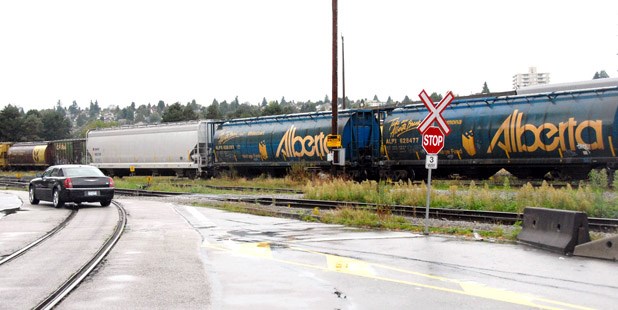The City of New Westminster and some of the railways traveling through the city are teaming up to press the federal government to improve railway safety.
In response to last summer’s tragic derailment and explosion in Lac Megantic, Quebec, the Transportation Safety Board of Canada has raised concerns about the safety of DOT-111 tank cars. The board believes that all DOT-111 cars that are used to transport flammable liquids should meet enhanced protection standards and these changes should be made as soon as possible in order to reduce risks.
“There are tens of thousands of these DOT-111 specification cars used in the railway industry. Pretty well all of them are owned by the shippers, by the oil companies that produce the chemicals or produce the oil,” said Singh Biln, director of community relations and chief mechanical officer for Southern Railway of British Columbia. “Of course, we are all concerned about the safety requirements.”
Biln said it will be a “slow process” to modify or take all of the DOT-111 rail cars out of service because there aren’t enough tank cars available and the transport of oil by rail is growing, and will continue to grow as crude oil plants and tar sands plants go on-stream.
“It is going to be a longstanding problem,” he said.
The issue of the DOT-111 cars was one of the topics at the advisory panel’s March 12 meeting. The panel, which includes representatives from various railways, the community, city council and city staff, meets quarterly to discuss various issues relating to railways in New Westminster.
The panel approved a motion that would ask city council to propose a resolution for consideration at the Union of B.C. Municipalities’ and the Federation of Canadian Municipalities’ conventions asking senior government to expedite the process in addressing concerns about the safety of the DOT-111 rail cars.
Coun. Chuck Puchmayr, the panel’s co-chair, said CN is on record saying it would like to see the DOT-111 rail cars eliminated or upgraded sooner rather than later.
Mike LoVecchio, director of government affairs for Canadian Pacific, said CP’s chief executive officer Hunter Harrison has stated there can and should be steps taken now to upgrade the fleet. He said the railroads don’t own the tank cars, and are legally required under the Canadian Transportation Act to move the rail cars and the products they contain.
“We have a legal obligation to move it right now,” he said. “Our view is the DOT-111 is an old design standard. It can and should be upgraded.”
LoVecchio noted that Canadian Pacific implemented a toll several weeks ago on the DOT-111/111A rail cars as an incentive to encourage its customers to get on with the process of upgrading.
“That’s a step we can take within Canadian law, and we have done so,” said LoVecchio, who was sworn in as co-chair of the panel at its March 12 meeting. “Is this the only thing we can do? Frankly, meetings such as this bring a tremendous voice because we speak as one. My view is that both through the FCM and New Westminster directly should speak up and should encourage federal regulators to take a stand and support the railroads in our efforts on this front.”
According to LoVecchio, the Transportation Safety Board has no power to order the tank cars out of existence, but it can make recommendations.
“It can’t order a tank car off of the tracks,” he said. “It can simply say, which it has said, in the Transportation Safety Board’s view, it is time for these cars to be retired. They make that recommendation to the Government of Canada.”
Biln told the City of New Westminster’s railway community advisory panel that he’s unaware of any loaded crude oil tank cars being handled in the past year, but has had some empty crude oil cars stored locally before they returned to Alberta.
“Our operations in all these municipalities where we handle these goods is usually 10 miles per hour or less,” he noted. “We don’t go high speed.”



